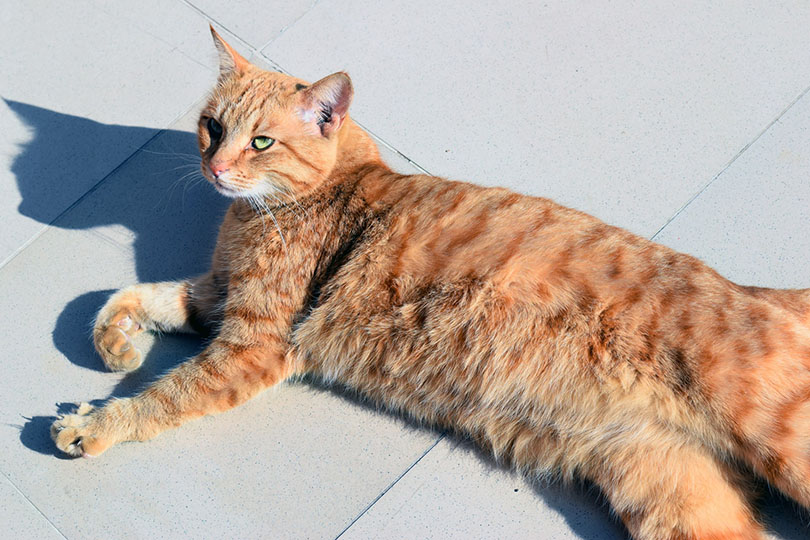Can Cats Overheat? Vet-Reviewed Signs & How to React
Updated on

Cats have a baseline body temperature that runs higher than that of humans, which is why you may see your cat curled up in a tight ball keeping warm when you think it’s perfectly comfortable in the house. But if a cat’s body temperature runs higher than a human’s, does this mean that cats can’t overheat? Or does it mean that cats can overheat, but only at a higher temperature than humans? Let’s talk about cats overheating.
Can Cats Overheat?
Cats can absolutely overheat. They can experience heat stress related to overheating and heat stroke. Heat stroke is a medical emergency that can lead to permanent damage to your cat’s internal organs, as well as death.

What Is a Normal Body Temperature for a Cat?
For cats, the normal internal body temperature is between 100–102.5°F. Anything above about 102.5 F in cats is considered febrile. A rectal temperature is often considered the most accurate type of temperature you may be able to get on your cat at home, so if you attempt to use a temporal (forehead) or tympanic (ear) thermometer, you may not get an accurate reading.
A temperature that meets or exceeds 105°F should cause concern for any cat, though. In fact, a body temperature this high could indicate that heat stroke is already occurring. A temperature this high would be the equivalent of a person running a temperature of at least 101°F or more. The difference is that most people can take over-the-counter medications that can help reduce fever without a visit to the doctor. However, over-the-counter medications can be deadly to cats, so this is not an option for cat owners.

What Are the Signs of Heat Stroke in Cats?
Rapid breathing, panting, and redness of the tongue and mouth can be early indicators that your cat is experiencing distress. A racing heart rate can also indicate this, and if the heart rate is high enough, you may be able to see your cat’s chest moving with the heartbeat. Vomiting and lethargy are also common symptoms associated with heat stress and heat stroke in cats. Stumbling or staggering around can indicate a serious problem happening with your cat and that some organs may already be shutting down.
How Can I Prevent My Cat from Overheating?
Overheating in cats can be related to a dangerously high fever, as well as a dangerously hot environment. Outdoor cats and cats left in vehicles, even with the air conditioner running, are at the highest risk of overheating. It’s necessary to always transport your cat in a carrier that provides plenty of air flow. Body heat can build up in your cat’s carrier, and without proper airflow, it will just get hotter and hotter with no reprieve for your cat.
If you are traveling with your cat, especially in hot temperatures, it’s essential that your cat gets time out of its kennel. This should only be done in a cool, enclosed environment or with your cat on a leash to prevent escapes.
If you have an outdoor cat, it should always have access to a cool, shaded place to spend time in. Cooling mats and ice cubes can also be used to help your cat keep their body temperature at a safe level. If your cat is showing signs of heat stress or heat stroke, do not give them ice cubes. We’ll talk about that in a minute.
If your cat is fully indoors, it’s still necessary to provide your cat with cool areas to spend time. Having parts of the house where windows and curtains stay closed or fans are running can help keep your cat cool. If your electricity goes out or there is a problem with your air conditioning, make sure your cat is in a well-ventilated room with access to cool water and a cooling mat if possible. You may even consider taking your cat to the vet or a boarding facility if this occurs to ensure your cat is cool and safe.

My Cat Might be Having a Heat Stroke…Now What?
If you think there is any chance your cat is having a heat stroke or is showing signs of heat stress, start heading to the closest vet clinic immediately.
Many people make the mistake of giving their cat ice cubes or giving them an ice or cold water bath when showing signs of heat distress. Unfortunately, this rapid change in body temperature can cause your cat to go into shock, leading to rapid organ failure and death.
It’s essential to bring the body temperature back down to normal slowly. This can be accomplished while you’re on the way to the vet by wrapping your cat in room temperature or slightly cool, damp towels. You can also use a little rubbing alcohol on the pads of the feet. This can help decrease the body temperature and it evaporates quickly, so it won’t leave your cat wet and at risk of cooling too quickly.
The vet will want to know how long your cat was exposed to extreme temperatures and what the temperature was, if possible. There is a big difference between 20 minutes in a hot car and 20 minutes in front of the warmest window in your air-conditioned house. If too long has passed, it’s possible that the vet will be unable to save your cat, so you should be prepared for this possibility.

In Conclusion
Cats can overheat, and it can be deadly if not handled properly and quickly. Veterinary intervention is necessary for a cat exhibiting signs of heat distress. If you choose to delay care to attempt to manage your cat’s situation at home, you may unintentionally lessen or eliminate your cat’s chances of survival. If you think your cat may be overheating, begin making attempts to slowly and cautiously decrease their body temperature while you start heading to the vet.
Featured Image Credit: Safoora Taimoor, Unsplash













